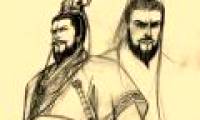
Chinese anthropologists will collect DNA samples from people who may be descendants of Cao Cao to prove their identity as a tomb in Ha Nam.

Chinese archaeologists claim to have discovered a large tomb thought to be Cao Cao's resting place, a politician and a famous military talent at the end of the Eastern Han Dynasty.

In the grave of Cao Cao's tomb there are three skeletons, one male and two female, and the inscription

Some Chinese scholars argue that there is not enough evidence to confirm the tomb in Ha Nam is the burial place of Wei King Cao Cao.

Chinese scientists have clear evidence that they have found the exact grave of the famous military reign of the Three Kingdoms, Cao Cao.

Archaeologists found in resettlement areas of Vinh Yen, Khanh Hoa, quartz lingas. This artifact can prove the belief of the well-developed Vinh Yen residents.

Chinese Institute of Archeology leaders affirmed that the ancient tomb excavated in Henan Province last month was Cao Cao's resting place, the famous reign of the Dong Han era.

Chinese archaeologists have just restarted the excavation of terracotta warriors after a 24-year hiatus.

Archaeologists discovered a series of ancient tombs that contained intact, still-decorated mummies.

The appearance of a Swiss watch in a 400-year-old tomb is confusing Chinese archaeologists.
 Chinese anthropologists will collect DNA samples from people who may be descendants of Cao Cao to prove their identity as a tomb in Ha Nam.
Chinese anthropologists will collect DNA samples from people who may be descendants of Cao Cao to prove their identity as a tomb in Ha Nam. Chinese archaeologists claim to have discovered a large tomb thought to be Cao Cao's resting place, a politician and a famous military talent at the end of the Eastern Han Dynasty.
Chinese archaeologists claim to have discovered a large tomb thought to be Cao Cao's resting place, a politician and a famous military talent at the end of the Eastern Han Dynasty. In the grave of Cao Cao's tomb there are three skeletons, one male and two female, and the inscription
In the grave of Cao Cao's tomb there are three skeletons, one male and two female, and the inscription Some Chinese scholars argue that there is not enough evidence to confirm the tomb in Ha Nam is the burial place of Wei King Cao Cao.
Some Chinese scholars argue that there is not enough evidence to confirm the tomb in Ha Nam is the burial place of Wei King Cao Cao. Chinese scientists have clear evidence that they have found the exact grave of the famous military reign of the Three Kingdoms, Cao Cao.
Chinese scientists have clear evidence that they have found the exact grave of the famous military reign of the Three Kingdoms, Cao Cao. Archaeologists found in resettlement areas of Vinh Yen, Khanh Hoa, quartz lingas. This artifact can prove the belief of the well-developed Vinh Yen residents.
Archaeologists found in resettlement areas of Vinh Yen, Khanh Hoa, quartz lingas. This artifact can prove the belief of the well-developed Vinh Yen residents. Chinese Institute of Archeology leaders affirmed that the ancient tomb excavated in Henan Province last month was Cao Cao's resting place, the famous reign of the Dong Han era.
Chinese Institute of Archeology leaders affirmed that the ancient tomb excavated in Henan Province last month was Cao Cao's resting place, the famous reign of the Dong Han era. Chinese archaeologists have just restarted the excavation of terracotta warriors after a 24-year hiatus.
Chinese archaeologists have just restarted the excavation of terracotta warriors after a 24-year hiatus. Archaeologists discovered a series of ancient tombs that contained intact, still-decorated mummies.
Archaeologists discovered a series of ancient tombs that contained intact, still-decorated mummies. The appearance of a Swiss watch in a 400-year-old tomb is confusing Chinese archaeologists.
The appearance of a Swiss watch in a 400-year-old tomb is confusing Chinese archaeologists.




 NASA's 'Ninth Planet' Shows Signs of Being Friendly to Life
NASA's 'Ninth Planet' Shows Signs of Being Friendly to Life Why did American astronauts have to be quarantined when returning to Earth?
Why did American astronauts have to be quarantined when returning to Earth? China surprises the world by building a cable-stayed bridge 'above the clouds'
China surprises the world by building a cable-stayed bridge 'above the clouds' Why do women sleep less and wake up more than men?
Why do women sleep less and wake up more than men? Revealing the secret inside the stuffed animal claw machine, from there, summarizing experience to help you increase your winning rate many times over
Revealing the secret inside the stuffed animal claw machine, from there, summarizing experience to help you increase your winning rate many times over What would happen if you dug a hole through the Earth and jumped in?
What would happen if you dug a hole through the Earth and jumped in? Camera takes a photo that lasts 1,000 years
Camera takes a photo that lasts 1,000 years Was there nuclear war in ancient times?
Was there nuclear war in ancient times?